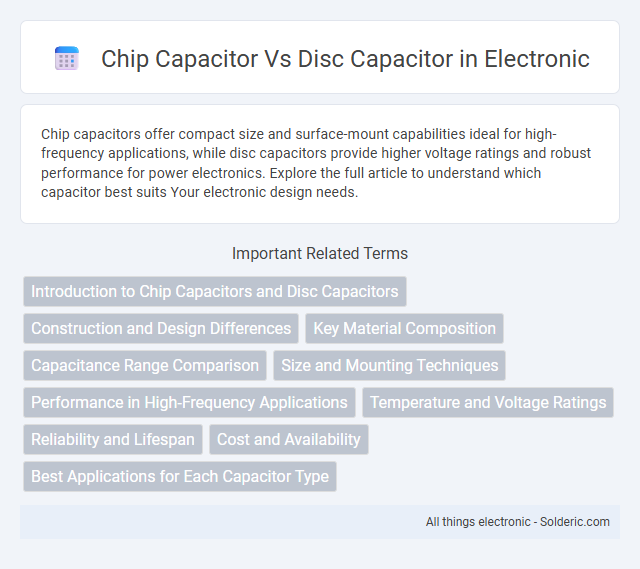Chip capacitors offer compact size and surface-mount capabilities ideal for high-frequency applications, while disc capacitors provide higher voltage ratings and robust performance for power electronics. Explore the full article to understand which capacitor best suits Your electronic design needs.
Comparison Table
| Feature | Chip Capacitor | Disc Capacitor |
|---|---|---|
| Shape | Rectangular, flat, surface-mount | Round, flat disc shape |
| Mounting Type | Surface-mount technology (SMT) | Leaded, through-hole |
| Size | Small, compact | Generally larger than chip capacitors |
| Capacitance Range | Typically pF to uF | Usually pF to nF |
| Voltage Rating | Low to medium voltage, up to a few hundred volts | Medium to high voltage, often higher than chip capacitors |
| Applications | High-density circuit boards, RF circuits, decoupling | General purpose, power supply filtering, and high voltage applications |
| Cost | Generally lower cost due to automated assembly | Often higher cost due to manual or mixed assembly |
| Reliability | High reliability in automated production | Good reliability but more susceptible to mechanical stress |
Introduction to Chip Capacitors and Disc Capacitors
Chip capacitors are surface-mount components widely used in modern electronic circuits for their compact size and high reliability, typically made from ceramic materials to provide stable capacitance values. Disc capacitors, often ceramic as well, feature a larger, disc-shaped design suited for through-hole mounting and applications requiring higher voltage ratings or energy storage. Both types serve essential roles in filtering, bypassing, and timing but differ significantly in form factor and mounting technology, influencing their use in various electronic devices.
Construction and Design Differences
Chip capacitors feature a compact, rectangular shape with multilayer ceramic dielectrics sandwiched between electrode layers, enabling high capacitance in a small footprint. Disc capacitors consist of ceramic or metalized film discs with radial leads, offering robust construction suitable for high-voltage applications. Your choice depends on the specific design requirements, such as size constraints and voltage ratings, where chip capacitors excel in miniaturization and disc capacitors provide durability.
Key Material Composition
Chip capacitors mainly use ceramic materials like Class 2 or Class 1 dielectrics, providing stability and high capacitance in small sizes. Disc capacitors typically feature ceramic or metalized paper dielectrics, designed for high voltage and pulse handling. Understanding the key material composition helps you select the right capacitor for your circuit's performance and reliability needs.
Capacitance Range Comparison
Chip capacitors typically offer capacitance values ranging from a few picofarads (pF) up to several microfarads (uF), making them suitable for high-frequency and surface-mount applications. Disc capacitors generally provide a broader capacitance range, from a few picofarads to several hundred microfarads, commonly used in power supply filtering and audio circuits. The narrower capacitance range of chip capacitors supports compact design and precise tolerance, while disc capacitors deliver higher capacitance values with larger physical sizes.
Size and Mounting Techniques
Chip capacitors offer a compact, rectangular shape suitable for surface-mount technology (SMT), enabling automated placement on printed circuit boards and saving valuable space in high-density electronics. Disc capacitors are typically larger, with a circular shape and wire leads, designed for through-hole mounting, which provides robust mechanical stability but occupies more PCB area. Your choice between chip and disc capacitors depends on the required size constraints and the preferred assembly method in your electronic design.
Performance in High-Frequency Applications
Chip capacitors exhibit superior performance in high-frequency applications due to their lower equivalent series inductance (ESL) and equivalent series resistance (ESR), enabling faster response times and reduced signal loss. Disc capacitors, while cost-effective and stable for low-frequency circuits, generally suffer from higher ESL and parasitic effects, limiting their efficiency at radio frequencies above 100 MHz. For RF circuits and high-speed digital systems, chip capacitors are preferred as they maintain consistent capacitance and minimal impedance under high-frequency stress.
Temperature and Voltage Ratings
Chip capacitors generally offer higher temperature ratings up to 125degC or more, making them suitable for applications exposed to heat, while disc capacitors typically operate reliably up to around 85degC. Voltage ratings vary, with chip capacitors available in a broader range, often exceeding 500V, whereas disc capacitors usually handle lower voltages, commonly below 500V. Understanding these differences ensures you select the right capacitor for your circuit's thermal and voltage demands.
Reliability and Lifespan
Chip capacitors generally offer higher reliability and longer lifespan due to their solid construction and resistance to mechanical stress, making them ideal for automated assembly and high-density circuit boards. Disc capacitors, while cost-effective and suitable for lower-frequency applications, tend to have shorter lifespans and are more susceptible to cracking and environmental damage. Choosing chip capacitors can enhance Your device's durability and ensure consistent performance over time.
Cost and Availability
Chip capacitors generally offer lower costs and higher availability due to standardized manufacturing processes and widespread use in surface-mount technology. Disc capacitors, while often more affordable for certain low-capacitance applications, tend to have less availability in modern SMT-oriented production lines. Bulk procurement of chip capacitors benefits from economies of scale, making them the preferred choice in mass electronics manufacturing.
Best Applications for Each Capacitor Type
Chip capacitors excel in space-constrained electronic devices, offering high reliability for surface-mount technology in smartphones, laptops, and automotive circuits. Disc capacitors are preferred for high-voltage applications like power supplies and audio equipment due to their robust construction and ability to handle surge currents. Your choice depends on the specific electronic requirements, such as size constraints and voltage handling capabilities.
Chip capacitor vs disc capacitor Infographic

 solderic.com
solderic.com